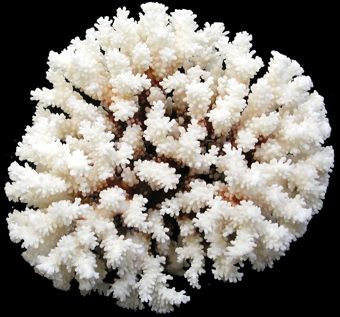A 10 to 12" Brownstem Coral cluster
A Brownstem Coral cluster measuring 10 to 12 inches.
Orders usually process within 2 to 5 business days.
Make Your Selections and Shipping Preference. We Will Email You the amount of the Shipping Cost. When you receive the shipping cost go back into Shells-of-Aquarius.company and click into Purchase Shipping Label. There you will find UPS or USPS. Click into the option you decided on and make your payment. Your order will ship when shipping payment is received.
Email: ja1@mindspring.com
This species belongs to the stony coral family Pocilloporidae. They are native to tropical and subtropical parts of the Indian and Pacific Oceans.
Pocillopora verrucosa is a colonial coral and grows into hemispherical clumps up to 30 cm (12 in) in diameter.[1] The branches are 1 to 2 cm (0.4 to 0.8 in) thick and usually have clubbed tips. The surface is covered with large verrucae (wart-like growths) up to 6 mm (0.24 in) high and the corallites (the stony cups from which the polyps emerge) are a fraction of an inch in diameter. The color of this coral varies and it may be yellowish-green, pink, brown or bluish-brown. It differs from Pocillopora damicornis in having broader, somewhat flattened, club-tipped branches and by the fact that its (verrucae a warty elevation on a plant or animal surface) are more evenly sized and spaced.
n biology, a colony is composed of two or more conspecific individuals living in close association with, or connected to, one another. This association is usually for mutual benefit such as stronger defense or the ability to attack bigger prey.
Pocillopora verrucosa is native to the tropical and subtropical parts of the Indian and Pacific Oceans. Its wide range extends from East Africa and the Red Sea to Japan, Indonesia, Australia, Hawaii, Easter Island and the western coast of Central America. They are found at depths down to about 177 feet but is most common between 3 to 49 feet. They are common in most of its range and are found on fringing reefs and moderately-exposed reef fronts but are less tolerant than P. damicornis of sediment and is therefore less common in lagoons.
Pocillopora verrucosa, like many corals, contains microscopic symbiotic dinoflagellate algae (zooxanthellae) living within their tissues. Through photosynthesis, these algae produce energy-rich molecules that the coral can assimilate. It has been found that these algae are already present in the eggs before spawning.
Pocillopora verrucosa can reproduce by fragmentation, a form of asexual reproduction. It is also a simultaneous hermaphrodite but its reproductive method varies across its range. Each polyp usually contains twelve gonads, the six nearest the mouth being ovaries and the other six spermaries. In South Africa the gametes are released simultaneously from both of these and spawning takes place at new moon in January (mid-summer) with the gametes being liberated into the water column. The Enewetak Atoll in the Marshall Islands, this species has been shown to fertilise the eggs internally and brood the developing planula larvae.
A number of predators feed on this coral. These include pufferfishes, parrotfishes and filefishes which feed on the tips of the branches and hermit crabs which scrape the skeletal tissue. Other animals feed on the soft tissues while leaving the skeleton intact including the butterflyfishes, the angelfishes and the damselfish, Stegastes acapulcoensis. Invertebrates which feed on this coral are the crown-of-thorns starfish (Acanthaster planci), Jenner's cowry (Jenneria pustulata), the sea urchin, Eucidaris galapagensis and the coral snails, Coralliophila spp.. Both the starfish and the cowry can kill a mature coral colony by stripping off the living tissue.
In general coral reefs around the world are being destroyed and although this coral is common and relatively resilient, it is likely that populations are in decline along with their habitat. The main threats are climate change, ocean acidification, bleaching and coral diseases. The IUCN has listed Pocillopora verrucosa as being of "Least Concern" as it considers that the rate of decline in its populations is not sufficient to justify listing it in a more threatened category. Like all corals, it is listed on CITES Appendix II.
Scientific classification
Domain: Eukaryota
Kingdom: Animalia
Phylum: Cnidaria
Class: Hexacorallia
Order: Scleractinia
Family: Pocilloporidae
Genus: Pocillopora
Species: Pocillopora verrucosa
Binomial name: Pocillopora verrucosa
Ellis and Solander, 1786
(REF: Hoeksema, B.W.; Rogers, A.; Quibilan, M.C. (2014). "Pocillopora verrucosa". IUCN Red List of Threatened Species. 2014)(REF: van der Land, Jacob (2018). "Pocillopora verrucosa (Ellis & Solander, 1786)". WoRMS. World Register of Marine Species)(REF: Hirose, M.; Kinzie, R. A.; Hidaka, M. (2000). "Early development of zooxanthella-containing eggs of the corals Pocillopora verrucosa and P. eydouxi with special reference to the distribution of zooxanthellae". Biological Bulletin. 199)(REF: Kruger, A.; Schleyer, M. H. (1998). "Sexual reproduction in the coral Pocillopora verrucosa (Cnidaria: Scleractinia) in KwaZulu-Natal, South Africa". Marine Biology. 132)(REF: Sier, C. J. S.; Olive, P. J. W. (1994). "Reproduction and reproductive variability in the coral Pocillopora verrucosa from the Republic of Maldives". Marine Biology. 118)
